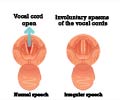Two distinct phenotypes of vocal cord dysfunction (VCD) – an involuntary functional disorder during inspiration often misdiagnosed as asthma – were identified in a long-term study…
Two distinct phenotypes of vocal cord dysfunction (VCD) – an involuntary functional disorder during inspiration often misdiagnosed as asthma – were identified in a long-term study published in the current issue of Annals of Allergy, Asthma & Immunology, the scientific journal of the American College of Allergy, Asthma and Immunology (ACAAI).
Investigators at the Pediatric Allergy and Pulmonary Division at the University of Iowa College of Medicine in Iowa City, Iowa, conducted a retrospective medical record review of 49 patients seen in the clinic who were diagnosed as having VCD. During the 13-year period, they observed two distinct clinical phenotypes: one group had VCD triggered only by exercise and the second group had spontaneous onset of symptoms not caused by exercise.Devang R. Doshi, M.D., and Miles M. Weinberger, M.D., observed that speech therapy, the currently accepted preferred intervention, was recommended for all patients in the spontaneous VCD group. For patients with exercised-induced symptoms, seven were prescribed a metered-dose inhaler containing a short-acting anticholinergic agent, and the remainder received no treatment.
Authors noted that the diagnosis of VCD was based on "direct laryngoscopy, reversible inspiratory airflow obstruction with spirometry during observed symptoms, or a convincing history of episodic inspiratory stridor that was rapid in onset and rapidly reversible in the absence of any other findings."
The symptoms of VCD can be mistaken for asthma because both can include labored breathing, an inspiratory noise often described as wheezing, chest tightening and shortness of breath. In VCD the symptoms are a result of an abnormal closing of the vocal cords rather than inflammation of the airways, as in asthma.
Of the 49 patients in the original study population, 41 had previously been diagnosed as having asthma as a cause of their symptoms before the diagnosis of VCD was established. Asthma was confirmed as a comorbidity in 12 of those patients.
The study also demonstrated that once diagnosed the long-term outcome of VCD is quite good. From the results of a structured telephone interview in 28 of the children and adolescents, the authors reported a complete absence of symptoms in 26 of the 28 contacted patients, at times ranging from one week to five years after the diagnosis.
Advertisement
(Source: Newswise)









